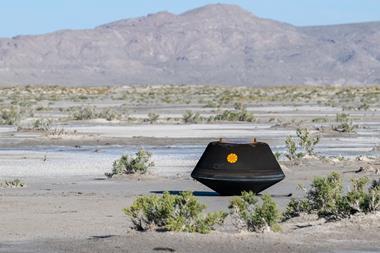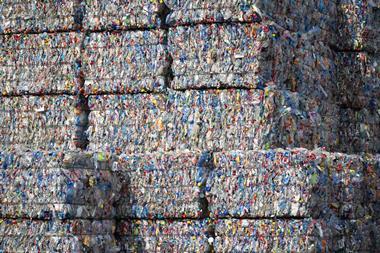Nasa’s rover Curiosity has discovered elusive pure carbonates on Mars, helping to solve the conundrum of how the planet was once warm enough to enable rivers to flow.1 What’s more, it also provides the first evidence of an ancient carbon cycle similar to that which makes Earth habitable but that it was likely out of balance causing it to ultimately peter out.

Evidence shows that water once flowed on Mars, meaning it must have had a much thicker atmosphere to create a warmer climate than the planet has today. Scientists have long thought that large amounts of carbon dioxide likely warmed Mars via the greenhouse effect for liquid water to become stable. However, this presented a mystery: where did all of the carbon dioxide go?
Models had predicted that it was probably sequestered in sedimentary rocks in the form of carbonate minerals and that these should be widespread across Mars. However, rovers and orbiters exploring the planet’s surface, as well as Martian meteorites retrieved on Earth, had only ever revealed scarce and impure amounts of carbonate minerals on Mars, further deepening the mystery.
Now, an international team using the CheMin (chemistry and mineral) instrument on board Curiosity, which uses x-ray diffraction to determine the chemical make-up of samples, has analysed rock samples from the Gale crater, a suspected dried-up lake, and discovered elevated concentrations of carbonates in the form of highly pure siderite – an iron carbonate.

‘One of the biggest questions in Mars science is “where are all the carbonates?”,’ says team member Benjamin Tutolo at the University of Calgary, Canada. ‘When it became apparent that these rocks contained siderite in such high quantities, I was unbelievably excited.’
Tutolo explains that finding highly pure siderite on Mars is distinct from all other identified Martian carbonates, which are less pure mixtures indicative of formation via hydrothermal processes. The purity of the Gale crater siderite, however, is a defining characteristic associated with the formation of sedimentary carbonates that sequester carbon dioxide from evaporated water. What’s more, the samples contained substantially more carbonate by weight than other previously investigated samples, up to 10.5% siderite by weight. ‘No one predicted that these rocks contained so much siderite – even the most detailed investigations of the orbital spectroscopy data acquired over these sedimentary rocks were unable to identify carbonate mineral,’ says Tutolo.
Masking minerals
The researchers think that the siderite evaded earlier spectroscopic detection because its signature was masked by other minerals, including highly soluble magnesium sulfate salts. Since similar rocks containing these salts have been previously identified globally, the team suggests these rocks probably contain abundant carbonate minerals too.
‘This is an exciting result that has large implications for the nature of the early atmosphere on Mars and a Martian carbon cycle,’ comments Wendy Calvin, a Mars scientist at the University of Nevada, Reno, US. ‘The detection of this strong signature in Gale crater suggests that their signatures may effectively be hidden in sulfate-bearing strata and that the global inventory of carbonate could be much larger than previously identified.’
‘Summing the carbonate that all of these deposits likely contain indicates that they may hold a substantial portion of the carbon dioxide that was formerly implicated in warming Mars,’ explains Tutolo. ‘The samples we studied finally provide evidence for the operation of an ancient Martian carbon cycle in some ways analogous to that which controls Earth’s habitability.’ Since the samples contained lower sulfate and iron oxide and iron hydroxide components, the team thinks that sulfate-rich brines likely dissolved siderite to release carbon dioxide back into the atmosphere to complete the cycle.
However, the evidence points to a carbon cycle that was unbalanced, whereby more carbon dioxide seems to have been sequestered than was returned back into the atmosphere. Tutolo explains that because Mars is further away from the sun than Earth, it needs substantially more carbon dioxide in its atmosphere to maintain habitable conditions. Therefore, this imbalanced carbon cycle could have seen the habitability of Mars slowly bleed away in its ancient past.
Janice Bishop at the SETI Institute, who co-authored a perspective piece on the findings, comments that the work offers important clues into how early Mars may have first become warm enough to form surface water, especially when tied with another recent Mars study that showed deep magnesium clays turned into more stable iron-rich forms when exposed to acidic water.2
‘Near surface magnesium clay and iron carbonate could have formed first through hydrothermal groundwater below the surface,’ Bishop says. ‘Gradually, as the carbonate dissolved via transient brines and carbon dioxide was released to the atmosphere, the planet would have gradually gained a thicker atmosphere that would have been able to warm the planet enough for liquid water to be stable on the surface for longer time periods, causing the rushing water features that carved the huge canyon 10 times the size of the Grand Canyon and many other smaller deltas and valley networks on Mars.’
References
1 B Tutolo et al, Science., 2025, DOI: 10.1126/science.ado9966
2 JD McNeil et al, Nat. Geosci., 2025, 18, 124 (DOI: 10.1038/s41561-024-01634-8)












No comments yet